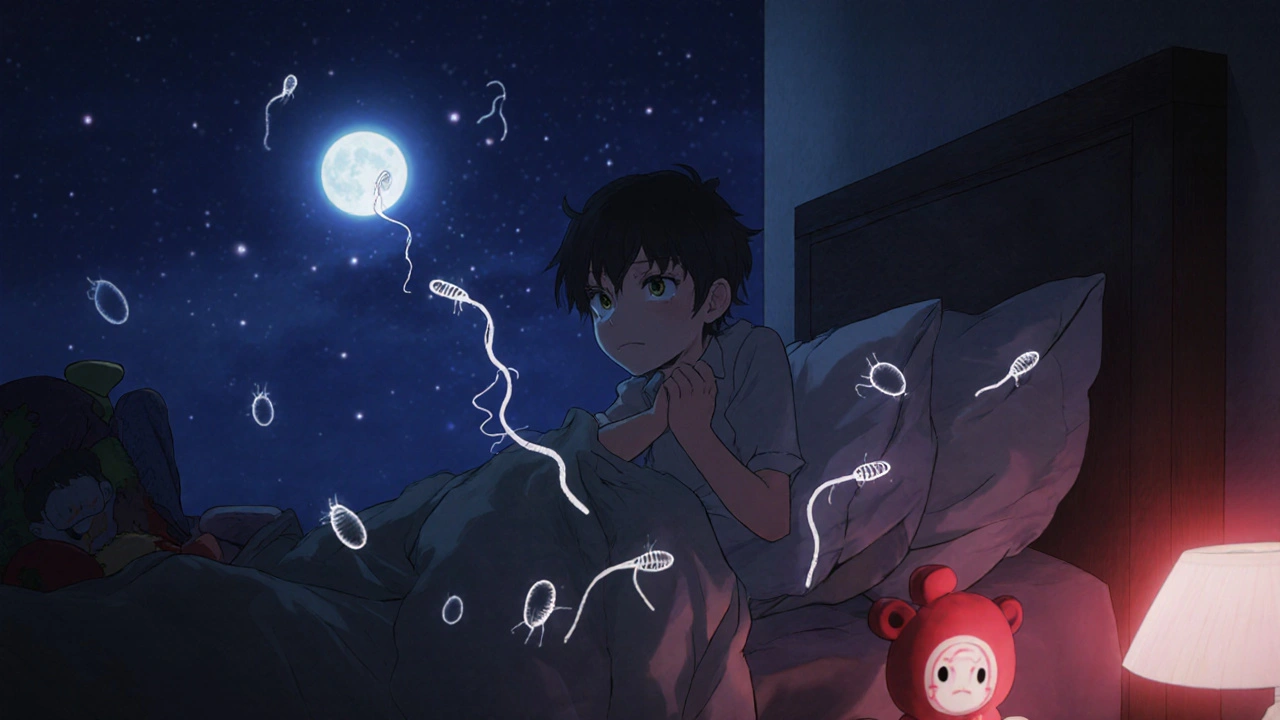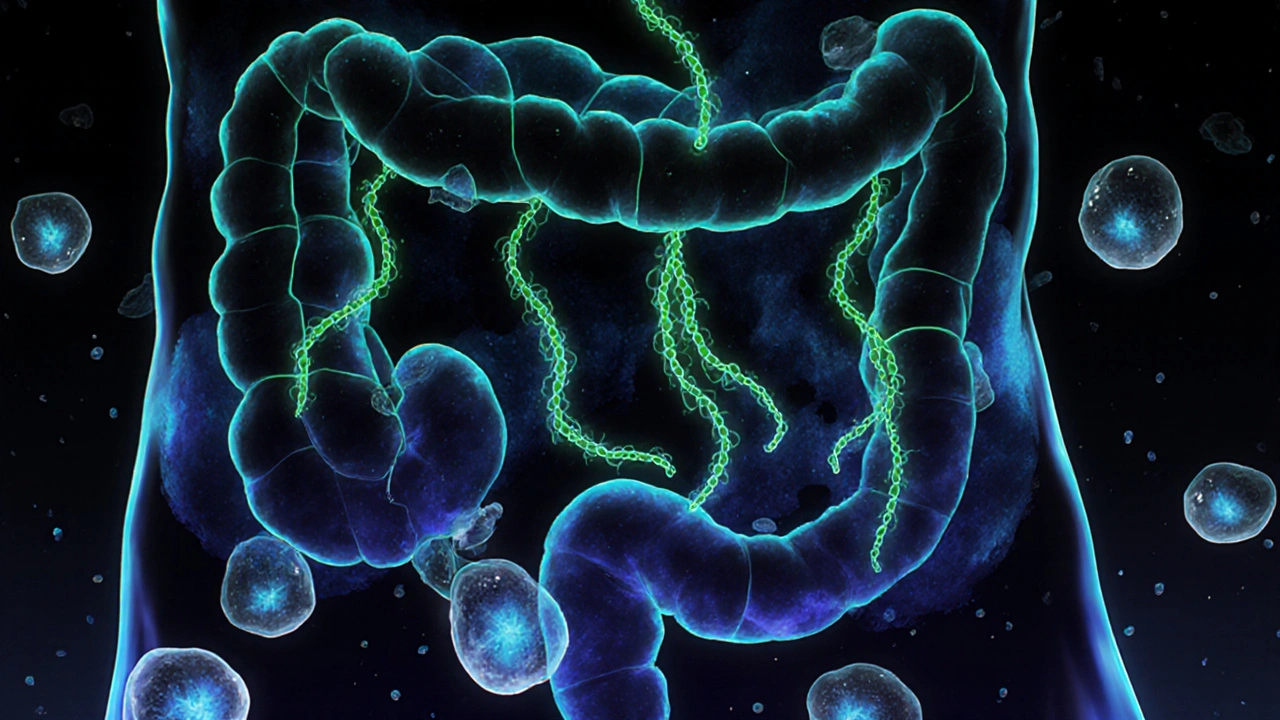What Giardia and Pinworms Really Do to Your Body
You might think parasitic infections are rare or something that only happens in faraway places, but that’s not true. In the U.S. alone, more than 1.2 million people get giardia every year. And pinworms? They’re so common that about 40 to 80 million Americans have had them at some point - mostly kids. These aren’t just minor annoyances. They cause real, lasting discomfort. Giardia attacks your gut lining, messes up digestion, and leaves you tired and bloated for weeks. Pinworms don’t burrow deep, but they make you itch so badly at night you can’t sleep. And if you don’t treat them right, they come back.
Giardia is a tiny, swimming parasite called Giardia lamblia. It hides in water as a tough cyst - like a spore - and survives for months in cold streams, lakes, or even tap water if it’s not filtered properly. You swallow it. Then, in your intestines, it turns into an active form that clings to the lining and destroys the tiny finger-like projections (microvilli) that absorb nutrients. That’s why people with giardia lose weight, get diarrhea, and feel exhausted. It’s not just a stomach bug. It’s a full-on gut sabotage.
Pinworms are different. They’re small, white worms, about the length of a staple. The female comes out at night to lay eggs around your anus. That’s when the itching starts - sharp, burning, and impossible to ignore. The eggs stick to your fingers, under your nails, on bedding, toys, even in the air. You touch something, then your mouth. And the cycle starts again. It’s not dirty hands alone that cause it. It’s the eggs surviving for weeks on surfaces, waiting to be swallowed.
How You Get Infected - And Why It’s Easier Than You Think
Most people think giardia comes from drinking dirty water in the wilderness. And yes, hikers and campers are at risk. But here’s the catch: you don’t need to go hiking. Outbreaks happen in daycares, nursing homes, and even homes with well water. A single infected child can spread it to the whole family through contaminated toys, doorknobs, or bathroom surfaces. The CDC says giardia is the number one cause of parasitic diarrhea in developed countries. That means your tap water, if not filtered, could carry it. Boiling for one minute kills it. Filters with pores smaller than 1 micron work too. But most home filters? They won’t touch it.
Pinworms spread even easier. You don’t need to eat bad food. You just need to touch a surface where eggs are hanging out - a bedsheet, a pencil, a toilet seat - and then touch your mouth. Kids are the main carriers because they don’t wash hands well. But adults who care for kids are just as likely to get infected. One study found that when one person in a household has pinworms, 75% of others test positive too. That’s not coincidence. That’s how contagious they are.
And here’s something most people don’t realize: both infections can be silent. You might have giardia and feel fine for weeks. Or you might have pinworms and never itch. But you’re still shedding cysts or eggs. That’s why outbreaks spread so fast. No symptoms doesn’t mean no risk.
What the Symptoms Really Look Like - And When to Worry
Giardia symptoms usually show up 1 to 14 days after swallowing the parasite. The classic signs: watery, greasy diarrhea that smells awful, bloating, gas that won’t quit, nausea, and sudden weight loss. Fatigue hits hard - like you’ve been run over by a truck. Some people get chronic symptoms that last months, with recurring diarrhea and nutrient loss. In rare cases, it triggers inflammation in the gut that mimics celiac disease. If you’ve had diarrhea for more than two weeks, especially after camping, traveling, or being around a sick child, get tested.
Pinworm symptoms are simpler: intense itching around the anus, mostly at night. You might see the worms - they’re white, thin, and move. Kids will scratch so much they get red, raw skin. Some adults complain of sleeplessness, irritability, or even abdominal pain. But here’s the twist: up to half of infected people feel nothing at all. That’s why the “scotch tape test” is so important. You press clear tape to the skin around the anus first thing in the morning, before bathing. Stick it to a slide. A doctor looks under the microscope. One test catches 50% of cases. Three tests? 90%. No guesswork.

How to Treat Giardia - And Why Some Treatments Fail
The go-to drug for giardia is metronidazole. You take 250 mg three times a day for five to seven days. It works for most people - 80 to 95% cure rate. But here’s the problem: 78% of people say it tastes like metal. Half get nauseous. Some stop taking it early. And if you don’t finish the full course, the parasite comes back stronger. That’s why tinidazole is becoming more popular. One 2-gram pill, taken once. Same effectiveness. Fewer side effects. Or nitazoxanide - 500 mg twice a day for three days. It’s safe for kids as young as one.
But here’s the real issue: treatment isn’t enough. If you take the medicine but don’t clean your environment, you’ll get reinfected. Cysts live on surfaces for weeks. Wash all bedding, towels, and clothes in hot water. Disinfect toilets, sinks, and toys. No one in the household should use the same towel. And if you work in food service or childcare, you need to stay home for two weeks after symptoms stop - even if you feel fine. The CDC requires it. Because you can still shed cysts.
And resistance? It’s rising. In Southeast Asia, 15% of giardia cases don’t respond to metronidazole. In North America, it’s still around 5%. But that number is climbing. That’s why doctors are now using stool antigen tests - not just looking under a microscope. Antigen tests catch 95% of cases. Microscopy? Only 70%. If your doctor skips the test and just prescribes medicine, ask for the antigen test. It’s more accurate.
Pinworm Treatment: The One Thing Most People Get Wrong
Pinworm treatment sounds simple: one pill. But most people fail because they stop there. The CDC recommends mebendazole (100 mg), albendazole (400 mg), or pyrantel pamoate. All work. But you need two doses - two weeks apart. Why? Because the first pill kills the worms. The second kills the new ones that hatched from eggs laid before treatment.
And here’s the part no one talks about: you have to treat everyone in the house at the same time. Even if they feel fine. Even if they’re not itching. Why? Because eggs are everywhere. A 2023 study found that families who treated only the infected child had a 60% chance of reinfection within a month. Families who treated everyone? Only 8% reinfection.
And cleaning? It’s not optional. Wash all pajamas, sheets, and towels in hot water. Dry on high heat. Vacuum carpets and upholstery. Wipe down doorknobs, light switches, and toys with disinfectant. Don’t shake bedding - that sends eggs into the air. The CDC updated its guidelines in January 2024: for stubborn cases, use three doses of albendazole (400 mg each, spaced two weeks apart). That’s 98% effective.
One Reddit user, u/GIWarrior, shared how his family kept getting pinworms. They treated twice. Still came back. Then they realized: the dog’s bed was contaminated. They didn’t even know the dog slept in the kids’ room. Once they cleaned everything - including the pet area - the itching stopped. No more pills needed.

How to Prevent These Infections for Good
Prevention isn’t about being paranoid. It’s about smart habits.
- Wash hands with soap and water for 20 seconds after using the bathroom, changing diapers, or before eating. WHO says this cuts transmission by 30-50%.
- Don’t drink untreated water - even from mountain streams. Use a filter with 1-micron pores or boil for one minute.
- Keep fingernails short and clean. Pinworm eggs get trapped under them.
- Don’t share towels, toothbrushes, or bedding.
- For kids in daycare: check if the facility has a handwashing routine. Ask about diaper-changing protocols.
- Consider point-of-use water filters if you have well water or live in an area with old pipes.
And here’s a quiet tip: if you’ve had giardia or pinworms, keep a bottle of alcohol-based hand sanitizer in your bag. Use it after touching public surfaces - especially before eating. It won’t kill giardia cysts, but it stops pinworm eggs from spreading.
What’s Changing in 2025 - And What to Watch For
Things are shifting. The WHO now recommends point-of-use water filters in high-risk areas. A trial in Bangladesh cut giardia cases by 42%. In the U.S., the CDC updated pinworm guidelines to include triple-dose albendazole for resistant cases. And research is moving fast: a giardia vaccine (GID1) is in early trials. It showed 70% immune response in volunteers last year.
But there’s a dark side. Climate change is making giardia more common. Warmer temperatures mean more runoff into water sources. By 2040, experts predict giardia will spread into 20-30% more temperate regions. That means more cases in places like the UK, Canada, and northern U.S. states.
Drug resistance is another worry. Metronidazole is losing its punch. Doctors are starting to use nitazoxanide or tinidazole as first-line, especially for travelers or recurrent cases. If your treatment didn’t work, don’t blame yourself. It might be the parasite - not you.
For now, the best defense is knowledge. Know how these parasites spread. Know how to treat them right. And know that cleaning your environment is just as important as taking the pill.
Can you get giardia from person-to-person contact?
Yes. Giardia spreads easily through the fecal-oral route. If someone with giardia doesn’t wash their hands after using the bathroom, they can contaminate doorknobs, food, or toys. Touching those surfaces and then your mouth can lead to infection. This is why outbreaks happen in daycares and households.
Do pinworms cause long-term damage?
Usually not. Pinworms don’t invade tissues or cause organ damage. The main issue is sleep loss from itching, which can lead to irritability, poor concentration, or secondary skin infections from scratching. With proper treatment and cleaning, there’s no lasting harm.
Is it safe to treat pinworms during pregnancy?
Mebendazole and albendazole are not recommended during pregnancy unless the infection is severe and the benefits outweigh the risks. Talk to your doctor. For mild cases, strict hygiene - washing hands, changing underwear daily, laundering bedding - may be enough to break the cycle until after delivery.
Can pets give you giardia or pinworms?
Giardia from dogs or cats is a different strain than the one that infects humans. It’s very rare for pets to pass human giardia to you. Pinworms only infect humans. So while pet hygiene matters, you don’t need to worry about catching these parasites from your dog or cat.
Why does giardia cause weight loss?
Giardia damages the microvilli in your small intestine - the tiny structures that absorb nutrients. Without them, your body can’t absorb fats, vitamins, or calories properly. Even if you eat normally, you lose weight because your body isn’t getting what it needs. This can lead to malnutrition if left untreated.
How long does it take to feel better after treatment?
Most people start feeling better within 2-3 days of starting treatment. Diarrhea and bloating usually clear up in a week. But full recovery can take weeks, especially if the infection was chronic. The key is finishing your medicine and cleaning your environment - otherwise, symptoms return.
What to Do Next - A Simple Action Plan
If you suspect giardia or pinworms:
- See your doctor. Ask for a stool antigen test for giardia. For pinworms, request the scotch tape test.
- If diagnosed, get the right medication. Don’t guess. Use CDC-approved drugs.
- Treat everyone in your household - even if they’re not sick.
- Wash all bedding, towels, and clothes in hot water. Dry on high heat.
- Disinfect bathrooms, kitchen surfaces, and toys.
- Practice strict handwashing for at least two weeks after treatment.
- Don’t return to work or school until you’re symptom-free and have finished treatment - especially if you handle food or care for children.
These infections are common. But they’re not inevitable. With the right knowledge and action, you can stop them - and keep them from coming back.

Bill Camp
November 20, 2025 AT 19:29